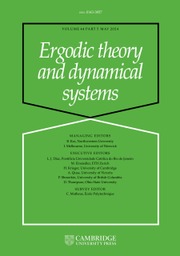No CrossRef data available.
Article contents
On non-tameness of the Ellis semigroup
Published online by Cambridge University Press: 30 June 2025
Abstract
A tame dynamical system can be characterized by the cardinality of its enveloping (or Ellis) semigroup. Indeed, this cardinality is that of the power set of the continuum  $2^{\mathfrak c}$ if the system is non-tame. The semigroup admits a minimal bilateral ideal and this ideal is a union of isomorphic copies of a group
$2^{\mathfrak c}$ if the system is non-tame. The semigroup admits a minimal bilateral ideal and this ideal is a union of isomorphic copies of a group  $\mathcal H$, called the structure group. For almost automorphic systems, the cardinality of
$\mathcal H$, called the structure group. For almost automorphic systems, the cardinality of  $\mathcal H$ is at most
$\mathcal H$ is at most  ${\mathfrak c}$ that of the continuum. We show a partial converse of this which holds for minimal systems for which the Ellis semigroup of their maximal equicontinuous factor acts freely, namely that the cardinality of
${\mathfrak c}$ that of the continuum. We show a partial converse of this which holds for minimal systems for which the Ellis semigroup of their maximal equicontinuous factor acts freely, namely that the cardinality of  $\mathcal H$ is
$\mathcal H$ is  $2^{{\mathfrak c}}$ if the proximal relation is not transitive and the subgroup generated by products
$2^{{\mathfrak c}}$ if the proximal relation is not transitive and the subgroup generated by products  $\xi \zeta ^{-1}$ of singular points
$\xi \zeta ^{-1}$ of singular points  $\xi ,\zeta $ in the maximal equicontinuous factor is not open. This refines the above statement about non-tame Ellis semigroups, as it locates a particular algebraic component of the latter which has such a large cardinality.
$\xi ,\zeta $ in the maximal equicontinuous factor is not open. This refines the above statement about non-tame Ellis semigroups, as it locates a particular algebraic component of the latter which has such a large cardinality.
Information
- Type
- Original Article
- Information
- Copyright
- © The Author(s), 2025. Published by Cambridge University Press


